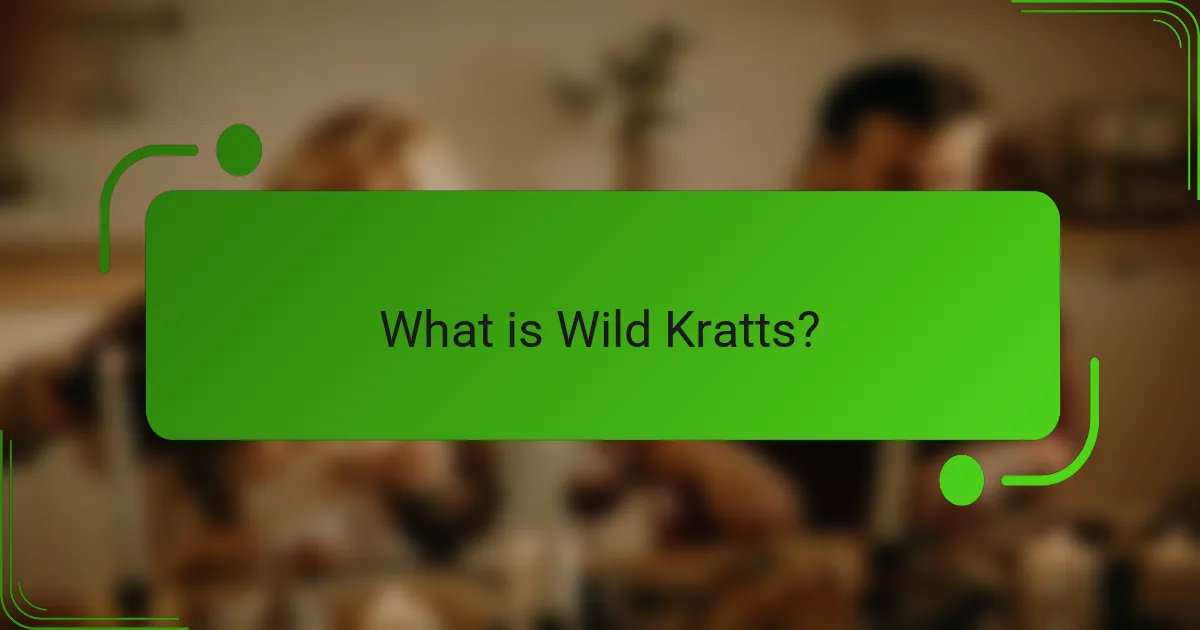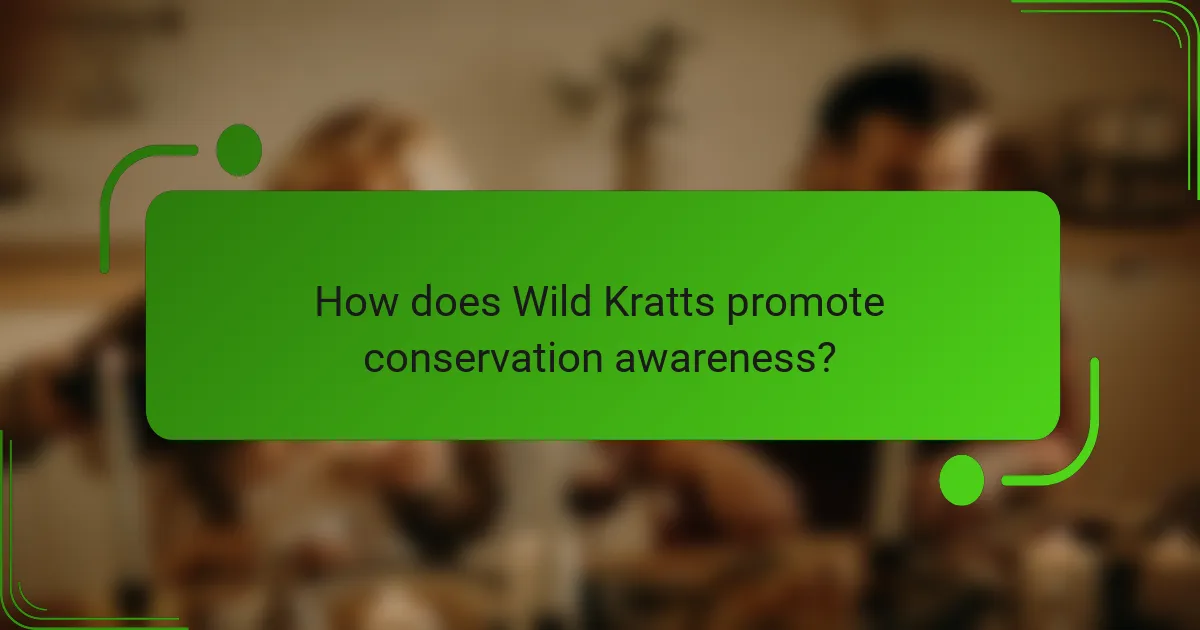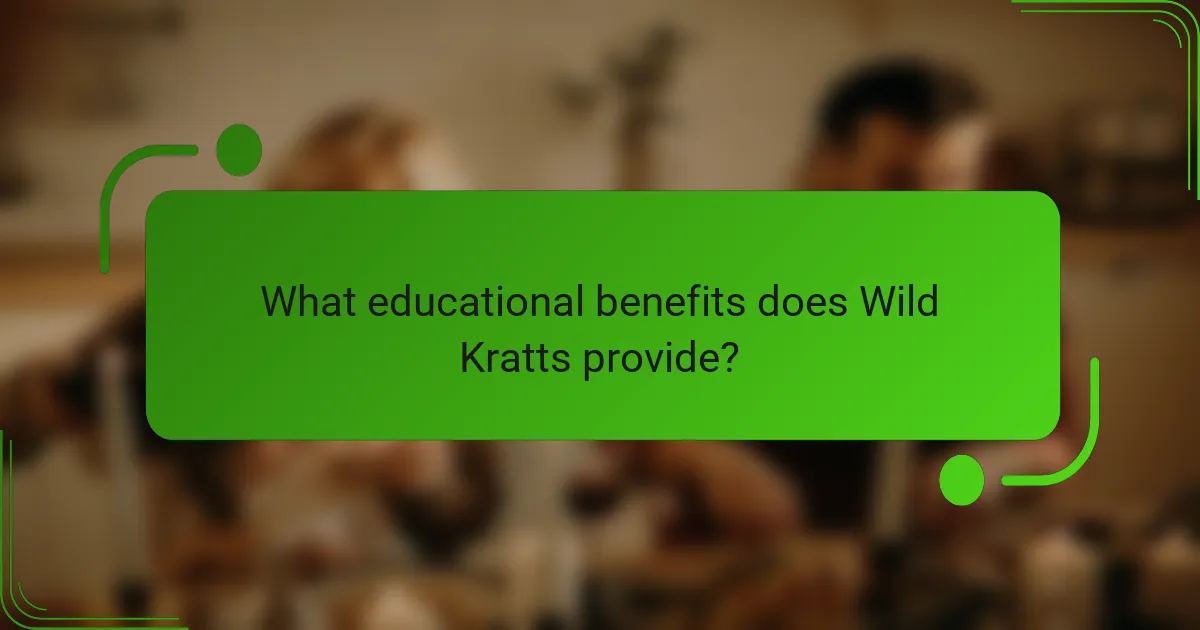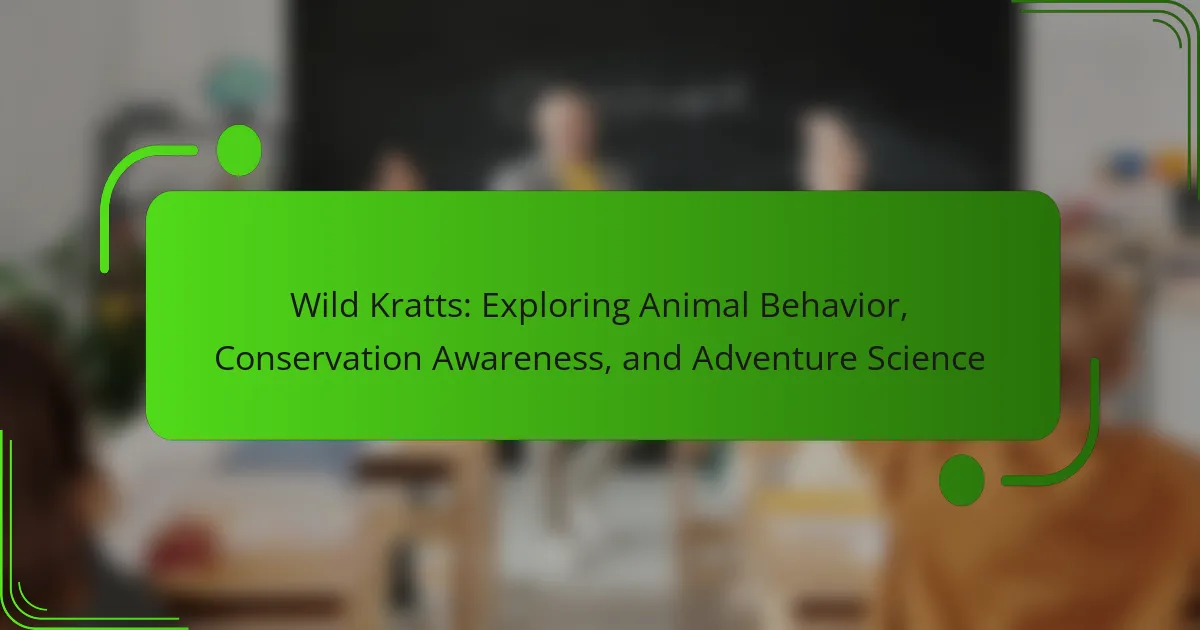Wild Kratts is an educational children’s animated television series that focuses on the adventures of the Kratt brothers, Chris and Martin, as they explore animal behavior and conservation. The show, which premiered in 2011 on PBS Kids, aims to teach children about various animal species and their habitats while promoting environmental awareness. Each episode features the brothers using technology to learn about wildlife, highlighting the importance of biodiversity and the need for conservation efforts. Wild Kratts effectively combines engaging storytelling with real-life science facts, encouraging young viewers to develop curiosity about nature and take action in their communities. The series has received positive reviews for its educational content and its alignment with science curricula, demonstrating significant benefits in enhancing children’s understanding of conservation issues.

What is Wild Kratts?
Wild Kratts is an educational children’s animated television series. It focuses on the adventures of the Kratt brothers, Chris and Martin. The show aims to teach children about animal behavior and conservation. Each episode features the brothers exploring various habitats and encountering different species. They often use technology to learn about the animals. The series incorporates real-life science facts and promotes environmental awareness. Wild Kratts first premiered in 2011 on PBS Kids. It has received positive reviews for its educational content and engaging storytelling.
How did Wild Kratts come to be?
Wild Kratts was created by Chris and Martin Kratt. The show first aired in 2011 on PBS Kids. It emerged from the Kratt brothers’ passion for wildlife and education. The concept combines animation with live-action segments. The series aims to teach children about animal behavior and conservation. It features the brothers transforming into animated versions of themselves. This allows them to explore the animal kingdom and its challenges. The show has garnered a positive response for its educational content.
Who are the creators behind Wild Kratts?
The creators behind Wild Kratts are Chris Kratt and Martin Kratt. They are brothers and wildlife enthusiasts. Both have backgrounds in biology and education. Chris and Martin Kratt previously worked on another children’s series called Zoboomafoo. Wild Kratts premiered in 2011 on PBS Kids. The show combines animation with live-action segments. It focuses on animal behavior and conservation. Chris and Martin aim to inspire children to appreciate wildlife.
What is the target audience for Wild Kratts?
The target audience for Wild Kratts is primarily children aged 4 to 8 years old. This age group is targeted because the show’s content is designed to be educational and entertaining for young viewers. Wild Kratts features animated adventures that introduce children to animal behavior and conservation. The characters, Chris and Martin Kratt, engage kids with fun storytelling and relatable experiences. The show also incorporates scientific concepts in a way that is accessible to young minds. By focusing on this demographic, Wild Kratts aims to foster a love for wildlife and environmental awareness from an early age.
What themes does Wild Kratts explore?
Wild Kratts explores themes of animal behavior, conservation awareness, and adventure science. The show emphasizes understanding wildlife and their habitats. It educates viewers on the importance of biodiversity and environmental stewardship. Each episode features exciting adventures that highlight various animal species. The series promotes curiosity about the natural world. It also encourages problem-solving through scientific exploration. Overall, Wild Kratts aims to inspire a love for animals and nature in its audience.
How does Wild Kratts address animal behavior?
Wild Kratts addresses animal behavior by showcasing various species and their unique traits. The show uses engaging storytelling to demonstrate how animals interact with their environments. Each episode features specific animal behaviors, such as hunting, mating, and social interactions. The Kratt brothers often transform into animals to illustrate these behaviors firsthand. This immersive approach helps viewers understand the significance of these actions for survival. Educational facts about the animals are presented in a fun and relatable manner. By combining adventure with science, the series effectively teaches children about wildlife. The program emphasizes the importance of respecting and conserving animal habitats.
What conservation messages are presented in Wild Kratts?
Wild Kratts presents several conservation messages focused on the importance of protecting wildlife and their habitats. The show emphasizes the interconnectedness of ecosystems and how each species plays a vital role. It highlights the threats posed by habitat destruction, pollution, and climate change. Each episode often features a specific animal and its unique challenges, educating viewers on their conservation status. The series encourages proactive behavior, such as supporting conservation efforts and understanding biodiversity. Additionally, it promotes empathy towards animals and fosters a sense of responsibility for the environment. These messages aim to inspire young audiences to become stewards of nature.
What adventures do the Wild Kratts embark on?
The Wild Kratts embark on adventures that focus on animal behavior and conservation. They explore diverse ecosystems around the world. Each episode features the Kratt brothers using technology and teamwork. They often encounter unique animal species and learn about their habitats. The adventures include rescuing animals in danger and solving environmental challenges. They also utilize “Creature Power” suits to gain abilities of different animals. These escapades aim to educate viewers about wildlife and the importance of conservation. The series promotes awareness of ecological issues while entertaining children.
How do the characters interact with wildlife during their adventures?
The characters in “Wild Kratts” interact with wildlife through observation, rescue, and education. They study animal behaviors in their natural habitats. The characters use technology, like Creature Power Suits, to mimic animal abilities. This allows them to engage directly with wildlife. They often help animals in distress or teach viewers about conservation. The show emphasizes respect for animals and their ecosystems. Each adventure highlights the importance of biodiversity and environmental protection. Facts about different species are shared to enhance understanding.
What educational aspects are integrated into the adventures?
The adventures in Wild Kratts integrate various educational aspects focused on animal behavior and conservation. They teach viewers about specific animal traits, habitats, and survival strategies. Each episode highlights real-life scientific principles related to biology and ecology. The show encourages curiosity about wildlife and promotes environmental stewardship. It also includes problem-solving scenarios that require critical thinking. By combining entertainment with education, the series effectively engages young audiences. Research shows that children retain information better when learning is fun and interactive. Thus, the educational content is designed to be both informative and enjoyable.

How does Wild Kratts promote conservation awareness?
Wild Kratts promotes conservation awareness by educating children about wildlife and ecosystems. The show features animated adventures that highlight various animal species and their habitats. Each episode focuses on a specific animal, illustrating its role in the ecosystem. The Kratt brothers use engaging storytelling to convey messages about environmental stewardship. They demonstrate the importance of protecting endangered species. The series also encourages viewers to take action in their communities. For example, it promotes activities like recycling and habitat restoration. Research indicates that educational programs like Wild Kratts can significantly enhance children’s understanding of conservation issues.
What specific conservation issues are highlighted in Wild Kratts?
Wild Kratts highlights several specific conservation issues, including habitat destruction, species extinction, and pollution. Habitat destruction is depicted through episodes showcasing deforestation and urban development impacting animal homes. Species extinction is addressed by featuring endangered animals and the importance of protecting their populations. Pollution is illustrated by the show’s portrayal of its effects on wildlife, such as plastic waste harming marine life. Each episode emphasizes the need for conservation efforts and raises awareness about these critical environmental challenges.
How does the show inspire young viewers to care for the environment?
The show inspires young viewers to care for the environment by showcasing animal habitats and ecosystems. It emphasizes the importance of biodiversity and conservation efforts. Each episode features real-world environmental challenges. The characters engage in problem-solving to protect wildlife. This encourages viewers to think critically about their own impact. Educational segments highlight sustainable practices. The show also promotes empathy towards animals. These elements foster a sense of responsibility for nature among young audiences.
What role do animals play in illustrating conservation concepts?
Animals play a crucial role in illustrating conservation concepts. They serve as examples of biodiversity and ecosystem health. For instance, keystone species, like sea otters, demonstrate the importance of species in maintaining ecological balance. Additionally, animals can symbolize the impact of human activities on habitats. The decline of polar bears highlights the effects of climate change on Arctic ecosystems. Educational programs often use animals to convey the urgency of conservation efforts. Documentaries and wildlife shows raise awareness about endangered species and their habitats. Engaging with animals fosters empathy and motivates conservation action among audiences. Overall, animals are vital in communicating the principles and importance of conservation.
What partnerships does Wild Kratts have with conservation organizations?
Wild Kratts partners with various conservation organizations to promote wildlife education and conservation. Their collaborations include organizations like the World Wildlife Fund (WWF) and the National Wildlife Federation (NWF). These partnerships aim to raise awareness about endangered species and their habitats. Wild Kratts utilizes their platform to educate children on the importance of protecting wildlife. They also engage in initiatives that support conservation efforts globally. Through these partnerships, Wild Kratts enhances its mission of fostering a love for animals and nature among young audiences.
How do these partnerships enhance the show’s impact?
Partnerships enhance the show’s impact by broadening its educational reach. Collaborations with educational institutions and conservation organizations provide expert insights. These partnerships bring real-world conservation issues into the narrative. They also facilitate access to resources and materials for audience engagement. For instance, joint initiatives often lead to interactive content and community programs. This approach fosters a deeper understanding of animal behavior and conservation. As a result, viewers are more likely to take action in support of wildlife protection. Overall, partnerships strengthen the show’s mission to educate and inspire.
What initiatives have emerged from these collaborations?
Collaborations from “Wild Kratts” have led to various educational initiatives. These initiatives include the development of interactive conservation programs. They aim to engage children in wildlife protection. Additionally, partnerships with environmental organizations promote awareness of animal behavior. Schools have adopted curriculum materials inspired by the show. These materials enhance science education and conservation understanding. The series also supports wildlife rescue efforts through fundraising campaigns. Such initiatives demonstrate a commitment to fostering a love for nature among young audiences.

What educational benefits does Wild Kratts provide?
Wild Kratts provides numerous educational benefits, primarily focusing on animal behavior and conservation. The show teaches children about different animal species and their habitats. It incorporates scientific concepts in a fun and engaging manner. Episodes often highlight the importance of biodiversity and environmental protection. The series encourages curiosity about nature and promotes critical thinking skills. Educational content aligns with science curricula for various age groups. Research shows that such programs enhance knowledge retention in young viewers. Overall, Wild Kratts effectively combines entertainment with educational value.
How does Wild Kratts teach children about animal behavior?
Wild Kratts teaches children about animal behavior through engaging storytelling and character exploration. The show features the Kratt brothers who transform into animals to experience their behaviors firsthand. Each episode highlights specific animal traits and adaptations. This approach allows children to learn about diverse species and their environments. The use of animated segments illustrates complex behaviors in a fun way. Educational facts are woven into the narrative, reinforcing learning. The show encourages curiosity about wildlife and promotes conservation awareness. Overall, Wild Kratts combines entertainment with education to effectively teach children about animal behavior.
What methods does the show use to engage its audience?
Wild Kratts uses interactive storytelling methods to engage its audience. The show incorporates animated sequences that illustrate animal behaviors. It also features live-action segments that connect with real-world conservation issues. Characters often ask questions to encourage viewer participation. The use of humor makes complex scientific concepts accessible. Educational songs and catchy phrases reinforce learning. The show promotes empathy towards animals, fostering a connection with viewers. Engaging visuals and vibrant colors capture the attention of young audiences.
How effective are these methods in conveying scientific concepts?
The methods used in “Wild Kratts” are highly effective in conveying scientific concepts. The show combines engaging storytelling with accurate scientific information. Animated visuals enhance understanding by illustrating complex ideas. Characters model curiosity and exploration, encouraging viewer engagement. Research shows that educational programming can improve science literacy. A study by the National Association for Media Literacy Education found that children retain information better when it is presented in an entertaining format. Thus, “Wild Kratts” successfully merges entertainment with education, making scientific concepts accessible and memorable for its audience.
What resources are available for educators using Wild Kratts?
Educators using Wild Kratts have access to various resources. The official Wild Kratts website offers lesson plans and activities. These materials align with science standards. Educators can find interactive games that reinforce learning. The PBS LearningMedia platform provides video clips and teaching guides. Additionally, there are downloadable worksheets available for classroom use. The Wild Kratts app includes educational games and videos. These resources support animal behavior and conservation education.
How can teachers incorporate Wild Kratts into their curriculum?
Teachers can incorporate Wild Kratts into their curriculum by using episodes to teach animal behavior and conservation concepts. Each episode features specific animals and their habitats, providing a basis for lessons in biology and ecology. Teachers can create lesson plans that align with state science standards, integrating the show’s themes. Activities can include discussions, projects, and hands-on experiments related to the animals featured in the series. For example, students can research animal adaptations showcased in episodes. Additionally, teachers can utilize Wild Kratts’ website for educational resources and interactive games. This approach enhances student engagement and reinforces learning objectives through multimedia content.
What supplementary materials support the educational content?
Supplementary materials that support the educational content include activity guides, lesson plans, and interactive games. These resources enhance the learning experience by providing hands-on activities related to animal behavior and conservation. Additionally, videos and documentaries offer visual context to the concepts presented in the educational content. Research shows that interactive materials increase engagement and retention in educational settings. For example, a study by the National Science Foundation found that supplementary resources improve understanding of complex science topics.
What are some practical tips for parents to enhance the Wild Kratts experience?
Parents can enhance the Wild Kratts experience by engaging children in related activities. Watching episodes together fosters discussion about animal behavior. Encourage kids to identify animals featured in the show. This helps reinforce learning. Create a Wild Kratts-themed scavenger hunt outdoors. This promotes exploration and physical activity. Use educational resources, like books or websites, to expand on episode topics. Discuss conservation efforts highlighted in the series. This builds awareness and responsibility towards wildlife. Lastly, encourage imaginative play by creating their own Wild Kratts adventures at home. These activities deepen understanding and enjoyment of the series.
Wild Kratts is an educational children’s animated television series created by Chris and Martin Kratt, focusing on animal behavior and conservation. The show, which premiered in 2011 on PBS Kids, engages children aged 4 to 8 through animated adventures that teach about various species and their habitats while promoting environmental awareness. Key themes include biodiversity, conservation challenges, and the importance of respecting wildlife. The series combines storytelling with real-life science facts and features partnerships with conservation organizations to enhance its educational impact. Additionally, Wild Kratts provides resources for educators and parents to further engage children in wildlife protection and learning.
